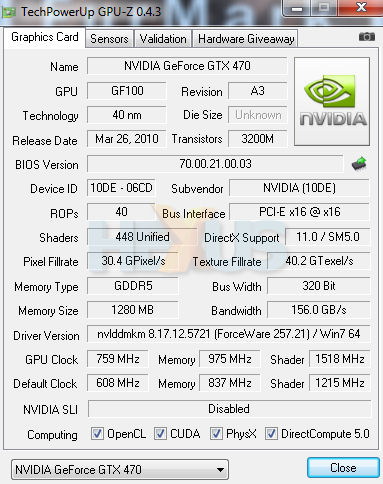How we test
Hardware
| Graphics cards | ZOTAC GeForce GTX 480 AMP 1,536MB | NVIDIA GeForce GTX 480 1,536MB | Inno3D GeForce GTX 470 Hawk 1,280MB | ZOTAC GeForce GTX 470 1,280MB | ASUS GeForce GTX 465 1,024MB | Inno3D GeForce GTX 295 1,792MB | BFG GeForce GTX 285 1,024MB | HIS Radeon HD 5970 2,048MB | ASUS Radeon HD 5870 MATRIX 2,048MB | Sapphire Radeon HD 5870 1,024MB | Sapphire Radeon HD 5850 1,024MB |
|---|---|---|---|---|---|---|---|---|---|---|---|
| Current pricing, including VAT | £450 | £400 | £330 | £300 | £235 | £400 | £275 | £550 | £400 | £325 | £235 |
| Shader model | 5.0 | 5.0 | 5.0 | 5.0 | 5.0 | 4.0 | 4.0 | 5.0 | 5.0 | 5.0 | 5.0 |
| Stream processors | 480 | 480 | 448 | 448 | 352 | 480 | 240 | 3,200 | 1,600 | 1,600 | 1,440 |
| GPU clock speed (MHz) | 756 | 700 | 759 (OC) | 607 | 607 | 576 | 648 | 725 | 850 | 850 | 725 |
| Shader clock speed (MHz) | 1,512 | 1,401 | 1,518 (OC) | 1,215 | 1,215 | 1,242 | 1,474 | 725 | 850 | 850 | 725 |
| Memory clock speed (MHz) | 3,800 | 3,698 | 3,900 (OC) | 3,348 | 3,208 | 2,016 | 2,484 | 4,000 | 4,800 | 4,800 | 4,000 |
| Memory bus width (bits) | 384 | 384 | 320 | 320 | 256 | 448 x 2 | 512 | 256 x 2 | 256 | 256 | 256 |
| CPU | Intel Core i7 965 Extreme Edition (3.20GHz, 8MB L3 cache, quad-core, LGA1366 - Turbo Boost on) | ||||||||||
| Motherboard | ASUS P6X58D Premium | ||||||||||
| Motherboard BIOS | 0703 | ||||||||||
| Mainboard software | Intel Inf 9.1.1.1025 | ||||||||||
| Memory | 6GB Crucial DDR3-1,067 CL7 | ||||||||||
| Memory timings and speed | 7-7-7-20 1T @ DDR3-1,066 | ||||||||||
| PSU | Corsair HX1000W | ||||||||||
| Monitor | Dell 30in 3007WFP - 2,560x1,600px | ||||||||||
| Disk drive(s) | Corsair Nova V128 SSD | ||||||||||
| Graphics driver | Release 257.15 | Release 257.15 | Release 257.21 | Release 257.15 | Release 257.15 | Release 197.13 | Release 197.13 | Catalyst 10.5 | Catalyst 10.5 | Catalyst 10.5 | Catalyst 10.5 |
| Operating system | Windows 7 Ultimate, 64-bit | ||||||||||
Software
| Benchmarks | Aliens vs. Predator DX11
benchmark Battlefield: Bad Company 2 v523648 - FRAPS-recorded benchmark Call of Duty: Modern Warfare 2 - ultra quality - FRAPS-recorded benchmark Crysis Warhead v1.1.1.711 - train map - enthusiast quality - FRAPS benchmark DiRT 2 v1.1, London map - ultra quality Power-draw Temperatures Real-world noise HEXUS.bang4buck and HEXUS.bang4watt |
|---|
Notes
As mentioned earlier, the Inno3D card ships at default frequencies for a GeForce GTX 470 - 607MHz core and 3,348MHz memory - and there's little point in benchmarking it at those clocks.
We undertook basic overclocking by increasing the voltage to the core from the default 0.97V to 1.05V - well within limits - and then increased frequencies until failure. Backing off a touch for stability reasons, we managed a rock-solid 759MHz core (1,518MHz shaders) and 3,900MHz memory. These frequencies represent a 25 per cent increase on the core and 16.5 per cent on the memory.

We've also updated the driver for the Inno3D card to 257.21 WHQL.
Appreciating that default-clocked performance will be the same as the compared ZOTAC GeForce GTX 470 card we've run a subset of overclocked numbers at the 1,920x1,200 resolution. This way we'll be able to see the effect of the overclock on our five games. Bear in mind that Inno3D doesn't guarantee any level of overclock.
The main comparison card here is the Radeon HD 5870, available for roughly the same outlay. We'll be concentrating on the two on the upcoming pages. The obvious caveat is that we're comparing stock-clocked performance against a HEXUS-overclocked card.









